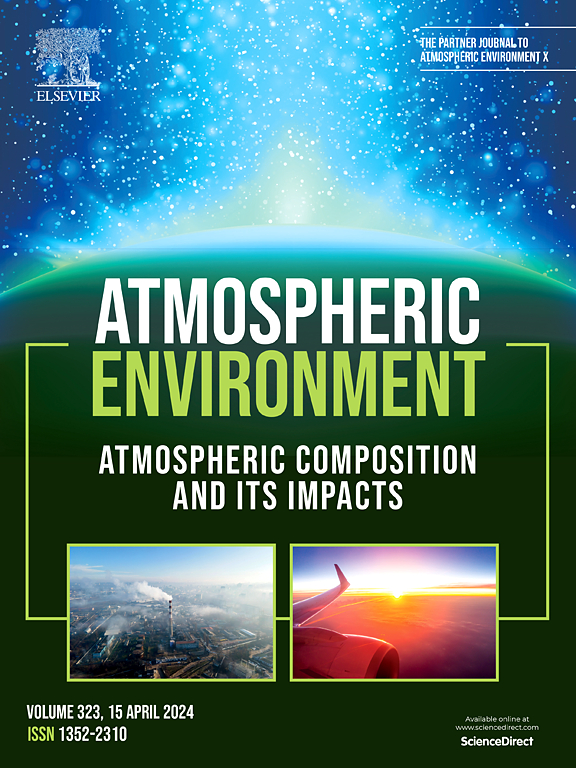基于相干多普勒激光雷达机器学习的青岛雾霾和沙尘PM2.5和PM10垂直分布反演方法
IF 3.7
2区 环境科学与生态学
Q2 ENVIRONMENTAL SCIENCES
引用次数: 0
摘要
准确描绘颗粒物(PM)的垂直分布仍然具有挑战性。本研究提出了一种利用单相干多普勒激光雷达(CDL)结合机器学习(ML)模型检索垂直PM浓度的新方法。模型的训练采用PM2.5和PM10实测数据作为真值,输入特征包括1550 nm处的粒子消光系数、CDL观测的信噪比、风速、风向以及ERA5再分析数据的温度和相对湿度。利用中国青岛冬季和春季(2020-2024)的观测资料进行模型开发和评价。PM2.5测试集对比的R2、RMSE、MAE分别为0.787、18.11 μg/m3、11.23 μg/m3, PM10测试集对比的R2、RMSE、MAE分别为0.803、29.98 μg/m3、18.93 μg/m3,模型表现良好。雾霾和沙尘事件的案例研究证明了该方法在捕获和表征PM垂直分布方面的能力。从统计结果来看,青岛市典型雾霾和沙尘事件的PM层主要集中在海拔1 km和1.2 km以内。利用CDL提供的风速和垂直速度等大气动力学信息,可以发现PM事件后期风速和负垂直速度的增强可能导致PM的消散和沉积。结合PM后向轨迹模拟结果表明,春节期间青岛市雾霾事件受局地排放和区域输运双重影响,而春季沙尘事件则表现为远程输运驱动的多阶段结构。这种基于CDL的方法为具有大气动力学信息的三维PM观测提供了一条有希望的途径,通过扩展CDL网络和ML应用提供了加强空气质量监测的潜力。本文章由计算机程序翻译,如有差异,请以英文原文为准。
PM2.5 and PM10 vertical distribution retrieval methods based on coherent Doppler lidar via machine learning: for haze and dust in Qingdao
Accurately profiling the vertical distribution of particulate matter (PM) remains challenging. This study presents a novel approach for retrieving vertical PM concentrations using a single coherent Doppler lidar (CDL) combined with machine learning (ML) models. The models were trained using in-situ PM2.5 and PM10 data as true values, along with input features including the particle extinction coefficient at 1550 nm, signal-to-noise ratio, wind speed, wind direction from CDL observations, as well as temperature and relative humidity from ERA5 reanalysis data. Observations from Qingdao, China, during winter and spring (2020–2024) were used for model development and evaluation. The models show good performance that the R2, RMSE, MAE of the PM2.5 test set comparison are 0.787, 18.11 μg/m3, 11.23 μg/m3, and those of the PM10 test set are 0.803 and 29.98 μg/m3, 18.93 μg/m3, respectively. Case studies of haze and dust events demonstrated the capability of this method in capturing and characterizing vertical PM distribution. From the statistical results, the PM layers of the typical haze and dust events in Qingdao were primarily concentrated within 1 km and 1.2 km in altitude, respectively. With the atmospheric dynamics information including wind speed and vertical velocity provided by CDL, the evidence can be found that the enhancement of wind speed and negative vertical velocity in the later phase of the PM events may result in the dissipation and deposition of the PM. Combining the PM backward trajectory simulation, the results show that the haze event during the Chinese Spring Festival in Qingdao was influenced by both local emissions and regional transport, while the dust event in the spring exhibited multi-phase structures driven by long-range transport. This CDL-based approach provides a promising pathway for three-dimensional PM observation with atmospheric dynamics information, offering the potential to enhance air quality monitoring through expanded CDL networks and ML applications.
求助全文
通过发布文献求助,成功后即可免费获取论文全文。
去求助
来源期刊

Atmospheric Environment
环境科学-环境科学
CiteScore
9.40
自引率
8.00%
发文量
458
审稿时长
53 days
期刊介绍:
Atmospheric Environment has an open access mirror journal Atmospheric Environment: X, sharing the same aims and scope, editorial team, submission system and rigorous peer review.
Atmospheric Environment is the international journal for scientists in different disciplines related to atmospheric composition and its impacts. The journal publishes scientific articles with atmospheric relevance of emissions and depositions of gaseous and particulate compounds, chemical processes and physical effects in the atmosphere, as well as impacts of the changing atmospheric composition on human health, air quality, climate change, and ecosystems.
 求助内容:
求助内容: 应助结果提醒方式:
应助结果提醒方式:


